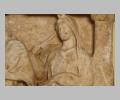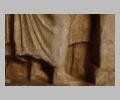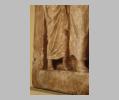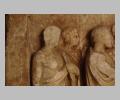| Collection: | Museum of Fine Arts, Boston |
| Title: | Votive relief to two divinities |
| Summary: | Worshippers approaching two divinities, perhaps Apollo and Artemis, at an altar |
| Object Function: | Votive |
| Material: | Marble |
| Sculpture Type: | Stele, relief-decorated |
| Category: | Single sculpture |
| Style: | Late Classical |
| Technique: | High relief |
| Original or Copy: | Original |
| Date: | ca. 325 BC |
| Dimensions: | H 0.545 m, W 0.71 m |
| Scale: | Miniature (pictorial field) |
| Region: | Attica |
| Period: | Late Classical |
Subject Description:
Four human males (shown at a small scale, two in low relief behind the two carved in higher relief), draped in himatia, approach a low rectangular altar behind which stand two deities shown in 3/4-view to the left. The male deity, resting his weight on his forward right leg, wears a himation draped diagonally over his left shoulder, and holds a staff in his extended right hand. The female deity, shown to be slightly shorter than the male deity, wears a himation draped over a chiton, and veiled over her head. She holds her veil with her right hand, rests her left hand at her waist, and looks out at the viewer. The tiny crescent on top of the head of the goddess identifies her as Selene, goddess of the moon, or Artemis, with whom she was often asssimilated. If she is Selene, then her companion might be Helios, the sun god; if Artemis, she would probably accompany her brother, Apollo. Vermeule & Comstock also suggest that the large male figure might represent a personification of a deme, or township of Attica. This latter suggestion is unlikely, however, as personifications of demes, or the people who inhabited them (demoi) are not attested on votive reliefs.
Form & Style:
The figural scene is framed on the bottom by a plinth, at the sides by antae, supporting an architrave with antefixes (7 of 9 are extant).
Date Description:
The date is based on a stylistic comparison with the decree relief of Euphron in Athens (
Condition: Nearly complete
Condition Description:
The faces of the figures have either been lost or are very worn. Some edges of the drapery have been broken. The corners of the altar are lost. Otherwise the relief within the pictorial field is reasonably well preserved. The frame is battered all around, and stained on the plinth.
Material Description:
Pentelic (Vermeule & Comstock)
Collection History: Acquired in 1977.
Sources Used:
Other Bibliography:





